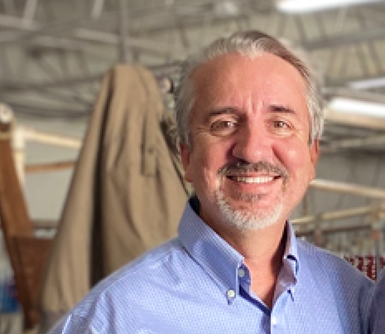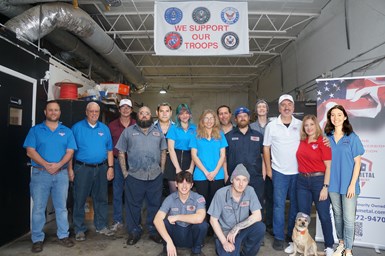An Interview with Andrew Kossowski, Veterans Metal
Andrew Kossowski, owner of Veterans Metal, a metal finishing business with a 30-year legacy, discusses his plan for transforming the company’s operations with smart technology and automations.

Andrew Kossowski
Photo Credit: Veterans Metal
Andrew Kossowski is the new owner of Veterans Metal, formerly DHS Enterprises, a 100% veteran- and minority- owned metal finishing business, operating out of Clearwater, Florida. Kossowski’s background includes a military career in the U.S. Air Force where he worked primarily in testing and quality assurance for the manufacturing and refurbishment of a variety of aircraft. After his military service, Kossowski worked as a telecommunications executive and also created a financial technology services start-up named Palgo.
Seeking a new venture that would allow him to combine his military background with his technological experience, Kossowski was drawn to DHS Enterprises, a veteran-owned company with a 30-year legacy offering a variety of finishes, including anodizing, chem film, and passivation. He saw in the company a solid business with growth potential through investment in new technology. Kossowski describes his plans for Veterans Metal as a transformation that will take place over the course of 2022. He took some time out of his busy schedule to tell Products Finishing about what’s in store for the company.
Tell us about your goal for 2022.
We want to address the fact we’ve been a 100% manual job shop in an outdated facility. Our goal is to transform as a 100% analog shop to a digitally- driven company. We feel strongly this will address our customers’ and employees’ needs while at the same time growing our business substantially.

The team at Veterans Metal.
Photo Credit: Veterans Metal
Can you talk specifically about some of the changes you’re making?
We intend to embrace transforming to digital platforms. For example, the temperature controllers for the tanks will be converted from analog devices to digital monitoring devices and controls. We want to be WiFi capable for controlling them remotely if we need to. We will also be using what is referred to as push technology as opposed to pull technology, where we use visual maintenance programs to proactively tell us, as an example, when titrations need to be performed. Many shops use periodic schedules for titration, but if your volume increases, and so does the use of the chemistry in your tanks. So, using a proactive digital model that measures the utilization of the tanks maintains better and more consistent results than running on a periodic basis.
What are you doing to improve turnaround time?
When addressing the turnaround for the customer, our focus turned to parts handling from receiving to shipping. The old model was 100% paper driven, and it was really prone to errors. The first thing we did was to immediately adopt a FIFO (first-in, first-out) model out and also implement an expedite model to give all of our customers the same equal opportunity to jump the line. But we needed software to be able to administer these new models.
With my background in computer science, we were able to build two applications. One was a scheduler that allowed us to schedule the parts as they came into the shop, and also permitted us to do load balancing and measure capacity for any expedited jobs for the day. For example, if we're exceeding capacity for a particular day, we wouldn't schedule it for that day, we would move it to the next day. The customer would be told our very honest assessment and when we expect to get those parts back.
Additionally, we put together a program that allows a single data entry point for the various documents necessary for managing parts. Traveler cards, packing labels, the labels for the containers, certificates of conformance, packing lists — originally those were being created individually and because of that were prone to errors. We developed a program with one entry point. There is no redundancy and combining the data entry for all those documents significantly improved our turnaround time for our customers. We’re completing POs [purchase orders] now in less than seven business days.
Tell us about the ways you are communicating with your customers.
Currently, we proactively inspect parts prior to processing and inform the customer of potential issues we see with the part. We photograph the parts in question and send them to the customer via text message or email. In the future, we are taking this communication to the next level. We plan to use a QR code system that automatically informs the customer where their PO is in the process. It will address not only scheduling of the internal paperwork, but also keep the customer informed on the status of their PO. I call it the pizza app for metal finishing.
We plan to provide the customer with a mobile or online app that makes it possible to see where their PO is at any point in the process. This includes a dynamic updating of the expected readiness for shipping date and time. If there is a delay, the delivery date will automatically be updated and the customer will receive a notification. If the part is going to be ready early, the app will automatically let the customer know it’s ready..
To hear more about Veterans Metal’s transformation project, check out the complete interview with Andrew Kossowski in an episode of our On the Line podcast: visit short.pfonline.com/OTL14. Follow Veterans Metal’s progress throughout the year as we check in with Kossowski at milestones in the company’s transformation.
Related Content
A Smooth Transition from One Anodizing Process to Another
Knowing when to switch from chromic acid anodizing to thin film sulfuric acid anodizing is important. Learn about why the change should be considered and the challenges in doing so.
Read MoreChicago-Based Anodizer Doubles Capacity, Enhancing Technology
Chicago Anodizing Company recently completed a major renovation, increasing its capacity for hardcoat anodizing and Type II anodizing.
Read MoreUnderstanding and Managing White Spots on Anodized Aluminum
Having trouble with spotting defects when anodizing? Taj Patel of Techevon LLC offers a helpful overview of the various causes of white spots and potential solutions.
Read MoreTrivalent Chrome Overview
As the finishing industry begins to move away from the use of hexavalent chromium to trivalent chromium, what factors should finishers consider as they make new investments? Mark Schario, chief technology officer for Columbia Chemical offers a helpful overview of this complicated topic.
Read MoreRead Next
Education Bringing Cleaning to Machining
Debuting new speakers and cleaning technology content during this half-day workshop co-located with IMTS 2024.
Read MoreDelivering Increased Benefits to Greenhouse Films
Baystar's Borstar technology is helping customers deliver better, more reliable production methods to greenhouse agriculture.
Read MoreEpisode 45: An Interview with Chandler Mancuso, MacDermid Envio Solutions
Chandler Mancuso, technical director with MacDermid Envio discusses updating your wastewater treatment system and implementing materials recycling solutions to increase efficiencies, control costs and reduce environmental impact.
Read More






















